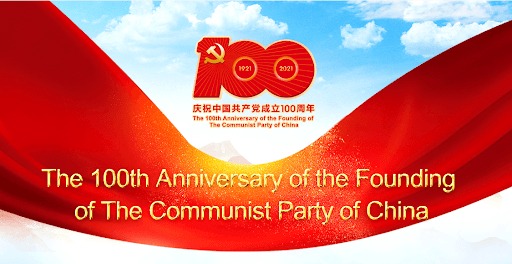|
Getting your Trinity Audio player ready...
|
The Communist Party of China (CPC) rides on countless achievements as it celebrates 100 years since its formation on July 1, 2021.
12 men who founded the party were fascinated by the new, poorly understood ideology of Marxism, which contended for influence with liberalism, social democracy, anarchism, fascism, and other isms that claimed to show how to restore China’s greatness.
The CPC has declared that it intends to make China a “strong, democratic, civilized, harmonious and modern socialist country.”
Lately, CPC presides over the world’s second-largest economy, soon to be number one if the trends continue.
Forty years ago, after decades of economic stagnation, China was not in the world’s top eight economies.
Today, thanks to a breathtaking social and economic transformation of CPC that began in the late 1970s.
Today as the CPC celebrates its centenary, China is on track to overtake the United States as the world’s number one economy within a few decades, if not sooner.
By some measures, it has already done so. Economists believe that we are now living in what many are now calling ‘The Chinese Century’.
But after three decades of spectacular growth, China is now moving into a slower growth phase – an inevitable result of its transition from a developing economy to a more mature, developed economy.
In the 1980s, 1990s, and early 2000s, China’s annual GDP growth frequently exceeded 10 percent, with an estimated 2019 growth of 6.3 percent, although this is likely to be closer to 6 percent with the impact of the US-China trade war.
In the coming years, the International Monetary Fund (IMF) forecasts China to continue growing at a rate of 6.3 percent in 2019 and 2020 and 6 percent in 2021.
These forecast figures still put it well ahead of most other major economies’ growth rates and keep it on track to eventually overtake the US as the world’s largest economy.
Manufacturing, services, and agriculture are the largest sectors of the Chinese economy – employing the majority of the population and making the largest contributions to GDP.
Since 1949, the Chinese Government has been responsible for planning and managing the national economy.
But it was only after 1978 – when Deng Xiaoping began market-based reforms –that growth began to take off, averaging 10 percent annually for some 30 years.
During that period, the size of the Chinese economy grew by roughly 48 times, from USD 168.367 billion (current prices) in 1981 to USD 11.01 trillion in 2015.
Since the introduction of Deng Xiaoping’s economic reforms, China has what economists call a socialist market economy – one in which a dominant state-owned enterprises sector exists in parallel with market capitalism and private ownership.
It was the active encouragement of private enterprise from 1978 that enabled China to kick-start the long expansionary boom that continues today. Private businesses now produce more than half of China’s GDP and most of its exports. They also create most new jobs.
The irresistible rise of China has implications and consequences for us all on so many levels and it largely comes down to one word: opportunity.
For Zimbabwe and Zimbabwean businesses in particular, has there ever been an opportunity like China?
Under the socialist-market model, the Chinese government plays a direct role in managing the economy through its five-year plans that set goals, strategies, and targets.
The five-year plans in the 1980s and 1990s focused on market-oriented reforms, while the past two five-year plans have focused on promoting more balanced growth, better wealth distribution, and improved environmental protection.
The current five-year plan focuses on increasing China’s competitiveness through more efficient and increasingly advanced manufacturing on the east coast, attracting labour-intensive manufacturing to central provinces, and increasing domestic demand.
Economic growth, which has in recent decades been driven by export-led manufacturing, is now becoming more reliant on domestic consumption.
The resulting increase in consumption spending represents a major opportunity for Zimbabwean businesses that are able to successfully target their products and services to an increasingly affluent Chinese public.
There is also encouragement for Zimbabwean businesses to invest in key areas such as advanced manufacturing, energy saving, environmental protection, and modern services.
Tightened regulation on energy conservation and environmental protection also presents an opportunity for Zimbabwean businesses.
For Zimbabwean businesses, opportunities in China have sprouted across a huge – some might even say bewildering – range of industries, market sectors, and geographic locations.
100 years and still going, the rewards can be immense for Zimbabwean businesses willing to put in the necessary preparation and hard work to address the current challenges and successfully establish investments with China.






